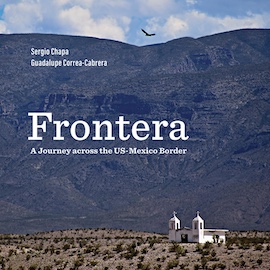El Centro
Third Generation Gangs Strategic Note No. 56: The Tren de Aragua in Chile: The Ronald Ojeda Kidnapping and Murder Case
About the Author(s)
SWJ El Centro Book Review – Frontera: a journey across the US-Mexico Border
About the Author(s)
Third Generation Gangs Strategic Note No. 55: Primeiro Comando da Capital (PCC) Expanding its Reach to Chile
About the Author(s)
Frontera: A Journey across the US-Mexico Border
Frontera: A Journey across the US-Mexico Border, a new illustrated book chronicling the US−Mexico frontier, has been released. The text by Guadalupe Correa-Cabrera, a SWJ−El Centro Fellow and Sergio Chapa, a freelance journalist and oil and gas expert, examines social, cultural, political, and security situation along the US-Mexico border from the Rio Grande Valley to the Pacific Ocean, stoping at border towns and cities along the way.

Publisher's description:
Following the border formed by the Rio Grande and moving cross-country to the Pacific Ocean, Frontera is a lavishly illustrated book that offers a comprehensive examination of the nearly two thousand-mile border shared by the United States and Mexico. The region has a reputation for being a dangerous place, with US Border Patrol and Mexican authorities playing cat and mouse with smugglers and undocumented migrants, and with drug cartels inflicting unspeakable violence on the region. Frontera takes an unblinking look at those dangers, but it goes beyond stereotypes and offers the reader vivid portraits of the beauty and complexity of the area—its history, its contemporary attractions, its rich cultural life. Moving through thirty-eight municipalities on the Mexican side and twenty-four counties in the US, Frontera includes maps, key cities, points of interest, border crossings, festivals, local cuisines, and more, along with analyses of local politics and security issues. Despite its troubles, the US-Mexico border is a beautiful place, the home of welcoming and warm people. It is a land of contrasts—austere landscapes and lush oases, thunderstorms and rainbows in the desert, robust industry and ghost towns, great wealth and aching poverty. Frontera is both a feast for the eyes and an encyclopedic reference that offers readers a clear-eyed perspective on a subject of critical importance to the United States and its southern neighbor.
Co-author Sergio Chapa describes the book in his article "Border Angels and Magic Moments" at the Texas Observer (26 January 2024).
Source: Guadalupe Correa-Cabrera and Sergio Chapa, Frontera: A Journey across the US-Mexico Border. Fort Worth: TCU Press, 2024 (Hardcover, 516 pages).
Organized Crime Groups and their Discourse in Mexico
About the Author(s)
SWJ El Centro Book Review – Narcas: The Secret Rise of Women in Latin America’s Cartels
About the Author(s)
Drugs, Elites and Impunity: The Paradoxes of Money Laundering and the “Too-Big-To-Fail” Concept
About the Author(s)
In Memoriam Major General Robert H. Scales, Jr.
In Memoriam Major General Robert H. Scales, Jr.
Small Wars Journal is saddened to acknowledge the death of Major General Robert Hinds Scales, Jr. (5 August 1944 – 12 January 2024). General Scales was a founding Small Wars Journal–El Centro Fellow. General Scales was a 1966 graduate of the United States Military Academy at West Point.

Robert H. Scales was involved as a founding SWJ–El Centro Fellow until his death in January 2024.He was one of America’s best known and most respected authorities on land warfare. He was President of Colgen, Inc, a consulting firm specializing in issues relating to landpower, wargaming and strategic leadership. Prior to joining the private sector Dr. Scales served over thirty years in the Army, retiring as a Major General. He commanded two units in Vietnam, winning the Silver Star for action during the battles around Dong Ap Bia (Hamburger Hill) during the summer of 1969. Subsequently, he served in command and staff positions in the United States, Germany, and Korea and ended his military career as Commandant of the United States Army War College. He is the author of Certain Victory, Firepower in Limited War, Future Warfare, Yellow Smoke: the Future of Land Warfare for America’s Military, The Iraq War: a Military History (with Williamson Murray), and Texas Border Security: A Strategic Military Assessment (with Barry McCaffrey). He was a graduate of West Point and earned his PhD in history from Duke University.

